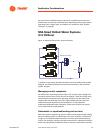
Application Considerations
SYS-APM001-EN Chiller System Design and Control 19
Constant flow
Constant flow is simple and often applied to small systems up to 200 tons—
as long as the system pressure drop is fairly low and a wider T is applied to
reduce the system flow rate. In constant flow systems, appropriate chilled-
water reset reduces chiller energy. These two strategies for saving energy
(reducing flow rates and/or chilled-water temperature reset) can be used
successfully in the constant flow designs more common in small chilled-
water systems. These two strategies are covered in “Selecting Chilled- and
Condenser-Water Temperatures and Flow Rates” on page 27 and “Chilled
water reset—raising and lowering” on page 87.
Constant flow systems use either a balancing or pressure-reducing valve or,
in a few cases, trim the pump impeller to set the system design flow.
Pressure-reducing valves waste pump energy. Another option designers use
to reduce pumping energy and increase system flexibility is to install a
variable frequency drive on the pump motor and set it at a constant speed
during system commissioning.
If, instead, system flow is balanced by trimming the pump impeller, flow
adjustment is much more difficult. Using a variable frequency drive at a set
speed allows the flow to be decreased or increased in the future if necessary.
This approach is more cost effective because the cost of variable frequency
drives has dropped. Any incremental cost will be offset by the elimination of
the balancing valves and pump starter.
Variable flow
Although a variable-primary-flow system may cost more than a constant flow
system, it is growing in popularity because it is less expensive than installing
a decoupled system. Another reason for its increased popularity is that pump
energy is reduced.
Some owners are concerned that the controls are more complex, but variable
flow systems can work very simply in the small chilled-water system when
there is only one chiller or when two chillers are piped in series. Key control
issues for variable flow systems are discussed in “Variable-Primary-Flow
Systems” on page 55, and variable flow with series chillers in “Series
Chillers” on page 44.
Condensing method
Many small chilled-water systems use air-cooled chillers because of the lower
maintenance requirements of the condensing circuit. Water-cooled systems
are generally more energy efficient and have more options for features such
as heat recovery, though some air-cooled chillers have partial heat recovery
options.
To help the owner decide on the system selection, a comprehensive energy
analysis is the best method of estimating the life cycle cost difference
between air-cooled and water-cooled systems. Energy analysis is likely
required for many facilities seeking LEED certification, so it may already be


















